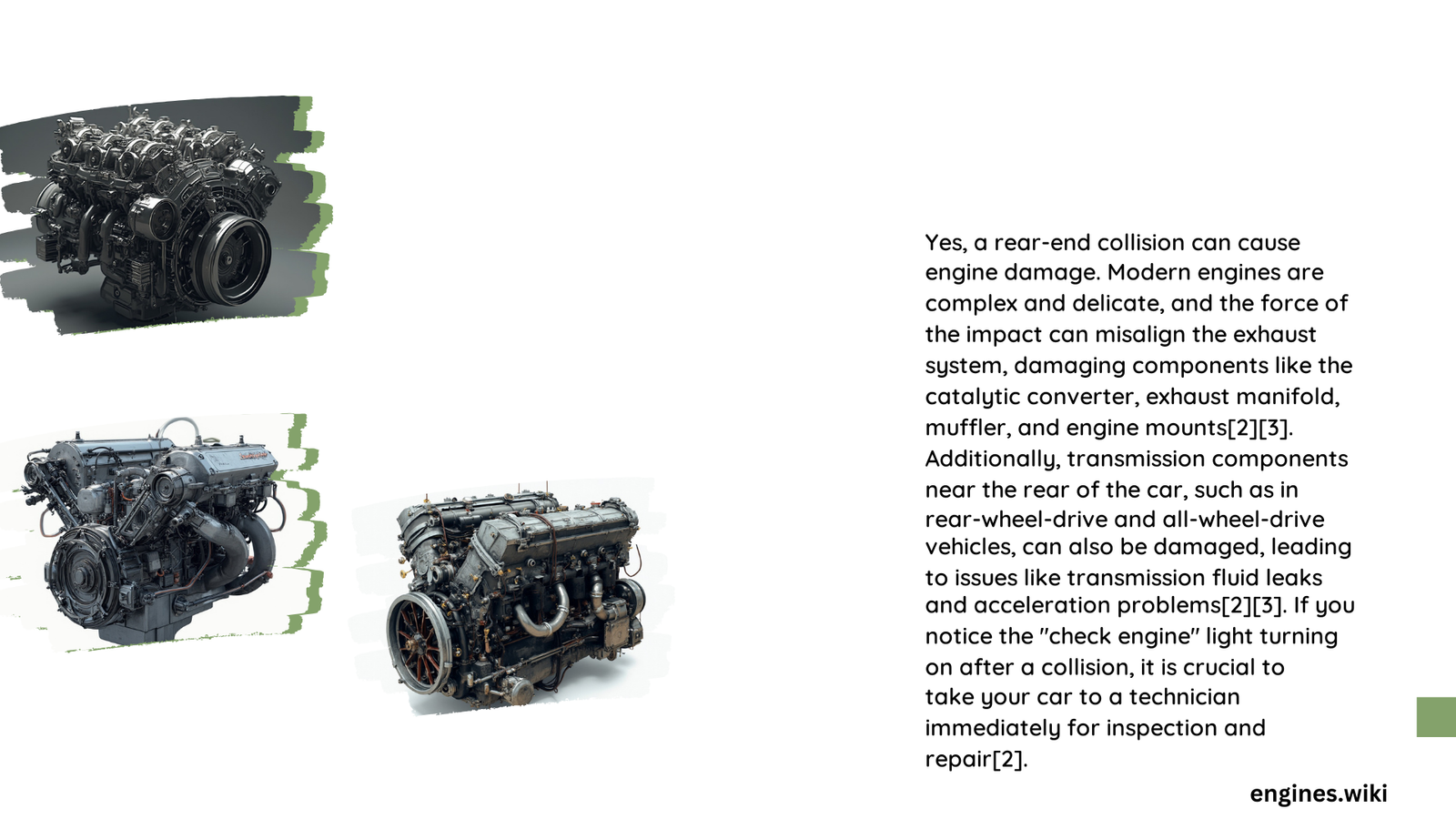Rear-end collisions can indeed cause significant engine damage. The force of impact transferred to the vehicle’s rear section can affect various engine components, including the exhaust system, engine mounts, drivetrain, and internal parts. The severity of damage depends on the collision’s force, with higher-speed impacts more likely to cause extensive damage. Even low-speed collisions can result in hidden issues that may not be immediately apparent but can lead to long-term problems if left unaddressed.
What Are the Most Commonly Affected Engine Components in a Rear-End Collision?
Rear-end collisions can impact several crucial engine components:
- Exhaust System: The impact can push the exhaust system forward, potentially damaging:
- Catalytic converter
- Exhaust manifold
- Muffler
-
\”Y\” pipe connected to the engine
-
Engine Mounts: The collision force can misalign or damage these, affecting:
- Engine stability
-
Overall performance
-
Drivetrain: Particularly vulnerable in rear-wheel-drive (RWD) and all-wheel-drive (AWD) vehicles:
- Transmission components near the rear can be damaged
-
May lead to acceleration and shifting issues
-
Internal Components: Hidden damage can occur to:
- Radiator
- Engine block
- Cylinder head
How Severe Does a Collision Need to Be to Cause Engine Damage?

The severity of engine damage correlates directly with the force of impact:
- Low-Speed Collisions:
- Can cause hidden damage like misalignment
- May result in minor exhaust system issues
-
Less likely to cause major engine damage
-
High-Speed Collisions:
- More likely to cause significant engine damage
- Can affect drivetrain, engine mounts, and internal components
- Higher risk of structural damage to the vehicle frame
It’s important to note that even seemingly minor collisions can cause issues that may not be immediately apparent but can lead to long-term problems if not addressed.
What Are the Potential Failure Rates and Repair Costs?
Failure rates and repair costs can vary widely depending on the collision’s severity and the specific components damaged. Here’s a general overview:
| Component | Potential Repair Cost | Failure Rate |
|---|---|---|
| Exhaust System | $200 – $2,000+ | Moderate to High |
| Engine Mounts | $200 – $1,000 | Low to Moderate |
| Drivetrain/Transmission | $1,000 – $5,000+ | Low (but costly when it occurs) |
| Internal Engine Components | $1,000 – $10,000+ | Low (but severe when it occurs) |
Note: These are rough estimates and can vary significantly based on the vehicle make, model, and extent of damage.
What Is the Process of Engine Repair After a Rear-End Collision?
The repair process typically involves:
- Thorough Inspection:
- Check for misalignment
- Identify exhaust leaks
-
Assess damage to internal components
-
Disassembly:
-
May be necessary to fully assess damage extent
-
Replacement of Damaged Components:
- Replace exhaust parts, engine mounts, or other affected components
-
May involve welding or frame repair if structural damage occurred
-
Realignment and Testing:
- Ensure proper alignment of all components
- Conduct performance tests to verify repairs
Timeframes for repairs can range from a few days for minor issues to several weeks or months for major repairs, depending on part availability and work complexity.
How Does the Type of Vehicle Affect the Risk of Engine Damage?
Different vehicle types have varying susceptibilities to engine damage in rear-end collisions:
- Rear-Wheel Drive (RWD) Vehicles:
- Higher risk of transmission and drivetrain damage
-
Components located near the rear are more vulnerable
-
All-Wheel Drive (AWD) Vehicles:
- Similar risks to RWD vehicles
-
Potential for damage to additional drivetrain components
-
Front-Wheel Drive (FWD) Vehicles:
- Generally lower risk of direct engine damage
- Still susceptible to exhaust system and engine mount issues
What Are the Long-Term Effects of Unaddressed Engine Damage?
Ignoring engine damage from a rear-end collision can lead to:
- Decreased engine performance
- Reduced fuel efficiency
- Increased wear on other vehicle components
- Potential for more severe and costly repairs in the future
- Safety risks due to compromised vehicle integrity
It’s crucial to have a professional inspection after any rear-end collision, even if no immediate issues are apparent.
How Can You Prevent Engine Damage in a Rear-End Collision?
While you can’t always prevent a rear-end collision, you can take steps to minimize potential engine damage:
- Maintain a safe following distance to reduce impact force if hit from behind
- Keep your vehicle in good condition with regular maintenance
- Install a rear bumper guard or reinforced bumper for additional protection
- Consider vehicles with advanced safety features that can help mitigate collision impacts
Remember, the best prevention is safe driving practices and staying alert on the road.
In conclusion, rear-end collisions can indeed cause significant engine damage, ranging from minor exhaust system issues to severe internal component damage. The extent of damage depends on various factors, including collision severity and vehicle type. Prompt professional inspection and repair are crucial to prevent long-term issues and ensure your vehicle’s safety and performance.
References:
1. Potential Vehicle Damage After a Rear-End Collision
2. Rear-End Collision: Damage To Look for After a Rear End Wreck
3. 5 Common Car Problems Following a Rear-End Collision
